I Think We Should Talk Midi-Chlorians
The Bane of Star Wars or Misunderstood Microbes?
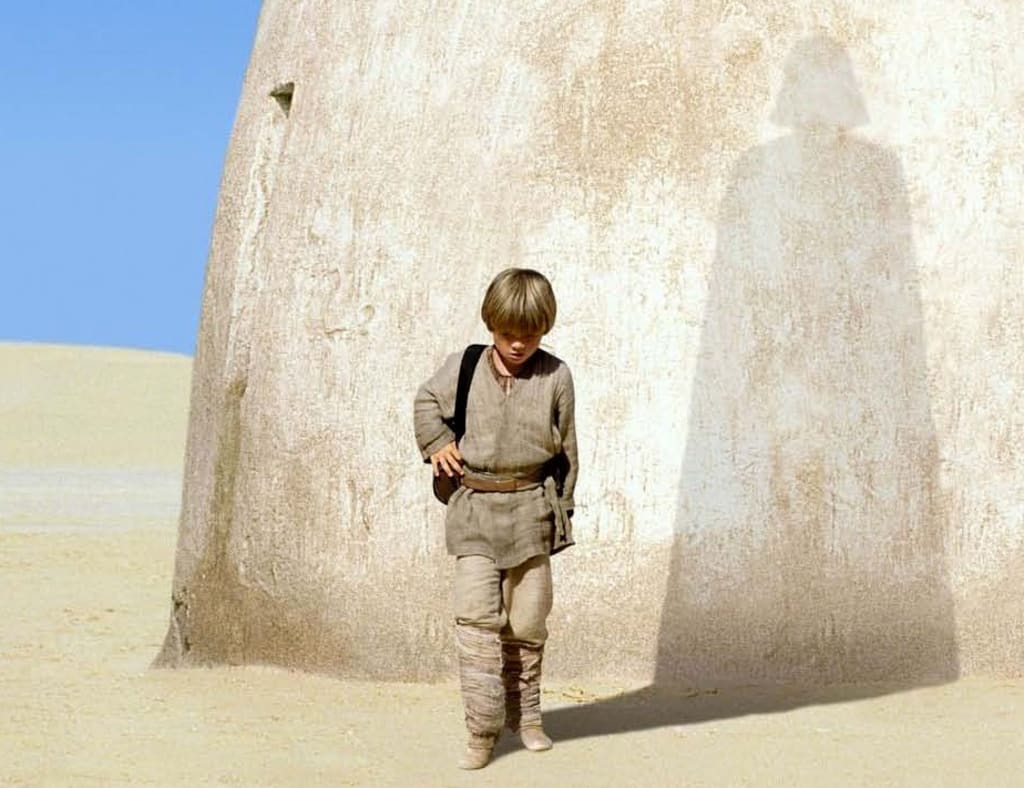
The Magical Mystery Force
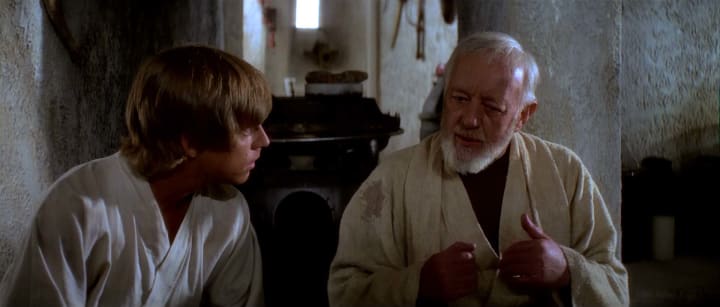
The Force, Explained...Kinda, in Episode IV: A New Hope
During the Star Wars original trilogy, the Force was described as something ethereal and spiritual, binding the galaxy together. And once you believed in it, you expected others, too, as well. Take Luke Skywalker, for instance. Upon meeting Obi-Wan Kenobi, he heard about the Force for what seemed to be the first time in his life. And yet, less than a day later, Luke was hammering the smuggler Han Solo for not believing in the Force!
Quickly, the Force works its spell…
Darth Vader also took a protective stance on the topic. If anyone exhibited a sassy attitude about the Force, he wasted no time Force choking them into showing some respect. The Force, whatever the heck is was, was not something to be trifled with.
Those were the good old days. But the prequels changed all of that, and it was George Lucas who did the trifling.
The Blood Is the Life
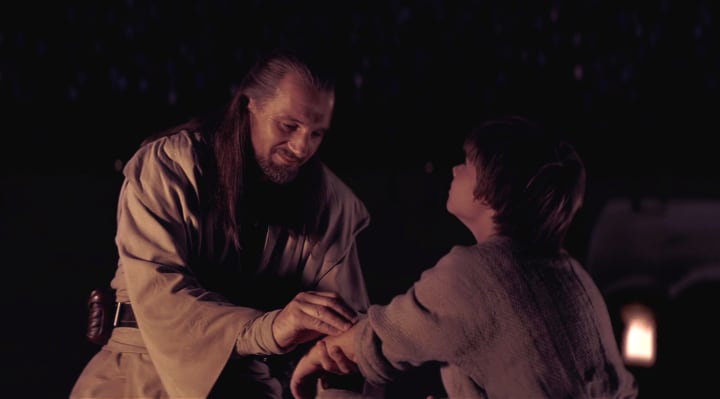
Just a Blood Sample, from Episode I: The Phantom Menace
Episode I: The Phantom Menace. Here, then, was George Lucas’ new take on the Force—it’s an energy field manipulated by a microcellular species of parasites, in tandem with their host. That’s the paraphrased version. Here’s what he actually said:
“I’m assuming that the midi-chlorians are a race that everybody knows about [in the world of Star Wars]. The way you interact and interface with this larger energy field [the Force] is through the midi-chlorians, which are sensitive to the energy. They are at the core of your life, which is the cell, the living cell. They are in a symbiotic relationship with the cell. And then, because they’re all interconnected as one, they can communicate with the larger Force field. That’s how you deal with the Force.”
Mm-hmm.
So there went over two decades of our assumptions about what the Force was, or at least how it is interacted with. It was, let’s say, a bit of a letdown. Even J.J. Abrams, in Episode VII: The Force Awakens, has steered wide in order to avoid any discussion about midi-chlorians. So in his film, the mystery remains intact. Nonetheless, the darn things are canon and they need to be dealt with.
As with many of the innumerable (and painful) changes wrought by the prequels, the concept of midi-chlorians does seem to make a few scenes from the original trilogy look nonsensical. For example, Admiral Motti’s ballsy, aforementioned complaint made directly to the Dark Lord himself during a staff meeting:
"Don't try to frighten us with your sorcerer's ways, Lord Vader. Your sad devotion to that ancient religion has not helped you conjure up the stolen data tapes, or given you clairvoyance enough to find the Rebel's hidden fort…guhkkk!!”
So, George—er, didn’t you say everyone in the Star Wars universe knows about these midi-chlorians…? I guess that’s everyone except the Head of Naval Ops aboard the Death Star.
Back to the Future
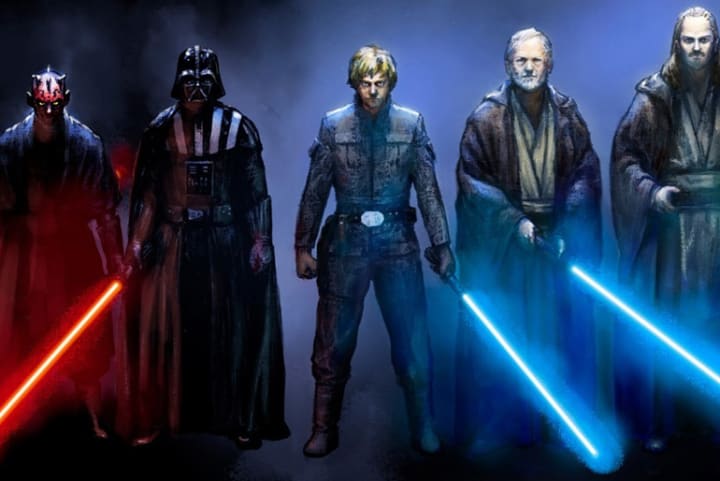
Strong in the Force
*Sigh*
Okay, let’s try to ret-con the ret-con. I guess everyone used to know about midi-chlorians, but then, like the Jedi, these cellular little guys vanished into myth for some reason. Fair enough. We know that as time went on, Lucas’ view of Star Wars changed quite drastically from the early, blurry days of the mid-70’s. In fact, initially, the Force was meant to be something which any person could control if they trained hard enough.
That was the general idea, but it became more and more clear that in fact certain people were not just stronger in the Force than others, but that they were naturally, inherently stronger in it. Luke, for example. From the time he left Tatooine with Obi-Wan until the time Obi-Wan’s final duel with Vader, the fully-grown Luke had only had a day to train as a padawan (a term not used in that film). Only a handful of hours of training, actually—on the Millennium Falcon (whilst enduring Han Solo’s taunts during most of the training session).
And yet Luke, as noted by Darth Vader himself, was strong in the Force. Why was he strong in the Force? Because of his father, of course.
The ability to manipulate the Force well was, then, genetic.
Return of the Jedi solidified this theory. Recall Leia’s proclamation to Luke:
“You have a power I don't understand and could never have.”
“You're wrong, Leia,” Luke told her. “You have that power too. In time you'll learn to use it as I have. The Force runs strong in my family. My father has it. I have it. And... my sister has it. Yes. It's you, Leia.”
There you go. The “power” that Luke has, the power to use the Force, or at least to use it better than average, is hereditary. Therefore the midi-chlorians, however they operate, pass into the bloodline from generation to generation.
The Way Ahead

Kylo Ren, from Episode VII: The Force Awakens
Reminder: Spoiler Alert includes Episode VII, The Force Awakens!
This is your last warning! Stop reading if you are that one guy who didn't watch The Force Awakens...
Kylo Ren seems to be yet another clear example of this, being a decedent of the Skywalker bloodline. Obviously not every single Force user in the Star Wars galaxy is kin to little Anakin, himself a fatherless creation of the midi-chlorians (a clear nod by Lucas to the Biblical story of Mary, mother of Jesus, and her immaculate conception…aka virginal birth). But that bloodline certainly does produce extremely powerful Force-wielders.
Like his future son Luke, Anakin was an adept pilot at a very young age, presumably because of a natural harmony with the Force, via the midi-chlorians. Remember that according to Jedi Master Qui-Gon Jinn and Obi-Wan, Anakin’s blood contains the highest count of midi-chlorians ever recorded (a count of over 20,000, if you want to be exact. Enough, apparently, to impregnate Shmi Skywalker, Anakin’s mother. Sort of begs the question, how powerful might Shmi have been if she’d been able to tap into her potential?).
Life As We Know It

Qui-Gon Jinn, from Episode I: The Phantom Menace
Qui-Gon summarizes the creatures to Anakin thusly: "Without the midi-chlorians, life could not exist, and we would have no knowledge of the Force. They continually speak to us, telling us the will of the Force. When you learn to quiet your mind, you'll hear them speaking to you."
That’s an odd statement. Life could not exist? If we take that claim at face value, it implies that every life form has some midi-chlorians, then. Wookiepedia indicates the same:
"Midi-chlorians were microscopic, intelligent lifeforms that live [sic] within the cells of all living beings. The Force spoke through the midi-chlorians, allowing certain beings to use the Force if they were sensitive enough to its powers." (The line is written in past tense, as if the midi-chlorians are no longer around; however this is likely an editorial error. As Grand Admiral Thrawn put it in Heir to the Empire, "Anyone can make an error, Ensign. But that error doesn't become a mistake until you refuse to correct it.” So unless this is kind of spoiler about the future of midi-chlorians, then I think it’s an error for Wookiepedia to correct).
So, giving Qui-Gon (and Wookiepedia) the benefit of the doubt, we may conclude that any person has at least some midi-chlorians creeping around in the veins. And reconciling that fact with Lucas’ original intent, that any person could acquire a knowledge of the Force, then the true limited factors are:
- The midi-chlorian count itself, because the higher it is, the higher the potential;
- The willingness to train in the ways of the Force.
Born Into It
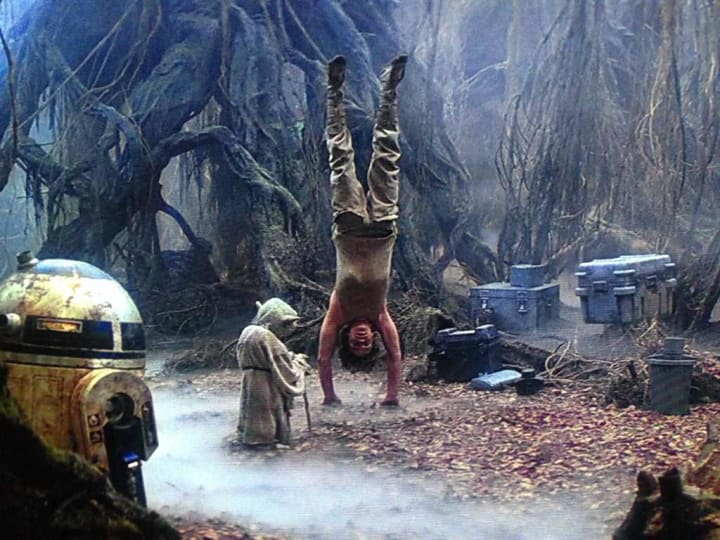
Luke in Training, from Episode V: The Empire Strikes Back
Stephen King wrote once: "While it is impossible to make a competent writer out of a bad writer, and while it is equally impossible to make a great writer out of a good one, it is possible, with lots of hard work, dedication, and timely help to make a good writer out of a merely competent one."
Let us, then, apply his dictum to the world of Star Wars!
So our bastardized quote might be:
It is impossible to make a Jedi out of a person with a low midi-chlorian count, and equally impossible to make a Master Jedi out of every person with a reasonable midi-chlorian count. But it is possible, with lots of hard work, dedication, and timely help to make a padawan out of someone with at least a decent midi-chlorian count.
King’s “great writers,” then, are BORN great. Note he doesn’t count himself as great, but merely a very hard-working good writer. Anakin, the Chosen One, had not only the highest midi-chlorian count, but he trained very hard for many years and under combat conditions…an important consideration, when you think about it. Many of the Jedi grew up in peacetime. Not Anakin. He “trained” while fighting actual high-stakes battles during the Clone Wars. His offspring Luke, on the other hand, had zero official training until he was grown, and then, as mentioned, only the most minimal lightsaber training and a bit of lecturing from Obi-Wan.
Allow me to excerpt Reddit user “Dargod,” who broke down Luke’s training regime more or less as:
- 19 years of life experience developing good and bad traits
- 3 years of basic Jedi training, understanding of the Force and fighting in an intergalactic conflict
- 1 week of the most complete master class about the Jedi and the secrets of the Force
- 1 duel with the Dark Lord of the Sith where he probably learned more about himself, the dark side, his fears and hatred than he would have with 5 years of theories in the Jedi Temple
So, 19 years more or less alone on the desert plains of Tatooine, in quiet conversation with the midi-chlorians…perhaps the best natural Force instructors one could have, if one were in a place quiet enough to feel their subtle influence without the distractions of a crowded city. In other words, a place like Luke’s childhood environment.
I’m not sure what Dargod refers to as “3 years of basic Jedi training,” but perhaps Luke was conversing with the Force spirit of Obi-Wan. There were no other Jedi around, apart from Yoda. Nonetheless, the point he raises is similar to what I wrote about Anakin’s wartime service—Luke finally started getting his hands dirty, fighting with the Rebellion.
Now, on to Yoda—Dargod asserts that Yoda may’ve spent his years in exile building up a master class in preparation for the day he’d again have a padawan to train. These years, of course, were on top of Yoda’s hundreds of years of prior experience…making him literally the best Jedi instructor anyone could ever hope for. Luke’s time on Dagobah was clearly limited…maybe only a few days, though the time period isn’t clear in The Empire Strikes Back.
Nonetheless, between Luke’s inherent abilities and Yoda’s supreme instruction, Luke makes light-year strides in a compressed period of time, enough to at least partially prepare him for…
The confrontation with Vader. Again, to Dargod’s credit, he notes that a battle with a Sith Lord was perhaps of more value than years of theoretical classroom discussions! Luke managed to not only impress Vader but to escape, barely, with his life—a pretty solid accomplishment for a padawan with probably the least amount of training in the history of the Jedi!
Then again, to be fair we should note that Vader’s intention was not to kill his son, but to ensnare him in carbonite. Vader, in other words, was holding back. Still, I don’t want to detract from Luke’s feat. He wasn’t ready to face Vader, but part of that had to do with his lack of emotional development, as Yoda informed him in the next film:
“Unfortunate that you rushed to face him... that incomplete was your training. Not ready for the burden were you.” By that, Yoda meant Luke wasn’t emotionally prepared to handle the truth…the truth that Vader was Anakin Skywalker, Luke’s dad.
The Force Awoke, but The Midi-Clorians Slept In
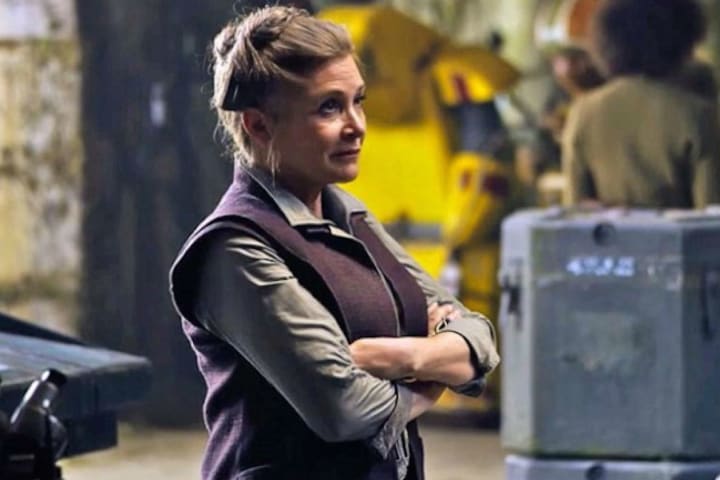
Yoda went on to say, “Luke, when gone am I, the last of the Jedi will you be. Luke, the Force runs strong in your family. Pass on what you have learned, Luke... There is... another...Sky...Sky...walker.” So Luke is, in this scene, humbly knighted. He’s a Jedi at that point; the last Jedi. Obi-Wan and Yoda are now dead. Leia has the potential, though, and Luke was charged with passing on his knowledge to her.
For some reason, it seems, that didn’t happen. Leia shows no signs in The Force Awakens of having received an ounce of Jedi training, despite the fact that her own midi-chlorian count must be off the charts, as Luke’s must also be. But she didn’t pursue the path.
Unfortunately the same cannot be said for Ben, her and Han’s son. Yet Kylo Ren’s knowledge and control over the Force seems to come from:
- His own natural abilities
- His supposed conversations with his grandfather, Darth Vader (which I believe are likely in his imagination, since Vader was clearly back to being Anakin Skywalker when we see his brooding smile on Endor, at the end of Return of the Jedi;
- His mentorship under the enigmatic Supreme Leader Snoke…whoever he is.
There seems to be a lot of room left to explore the possibilities and limitations of these midi-chlorians. We’ve yet to hear anything, for instance, about Snoke’s count, or Emperor Palpatine’s own count, or that of his apprentice Darth Maul or even Count Dooku. Palpatine made mention of midi-chlorians in Revenge of the Sith, when educating Anakin about the “tragedy” of Darth Plagueis the Wise, “a Dark Lord of the Sith so powerful and so wise, he could use the Force to influence the midi-chlorians to create life.”
What?
The midi-chlorians can create life, which we already knew since they created Anakin… In fact, possibly this scene was Palpatine relating his own knowledge of Anakin’s virginal birth, though that is unclear. Maybe Plagueis created somebody else. Whatever was written in the James Luceno novel, Star Wars: Darth Plagueis, is now considered Legend.
Because of course the Star Wars Expanded Universe did delve more into midi-chlorians but after the purchase of Lucasfilms by Disney, the entire EU was (I’m sure you know) swept into the category of “Legends,” and thus nearly decimated wholesale. They have, however, been referenced in three episodes of Star Wars: The Clone Wars animated TV show, which is considered a canonical part of the Star Wars universe (the episodes are: "Deception," "Voices," and "Destiny”).
Search your feelings. We have not heard to last of the midi-chlorians. They may not pop up in Episode VIII, or in Rogue One: A Star Wars Story. But there are still many stories left to tell, and eventually, when the galaxy is still and our hearts are open, we’ll hear the murmur of the midi-chlorians once more.
I have foreseen it.
About the Creator
Matt Cates
Freelance writer and owner of Cates Content and Copywriting; retired Air Force Veteran; former administrative assistant at Oregon State University; author of Haveck: The First Transhuman, the greatest sci-fi novel in the multiverse.






Comments
There are no comments for this story
Be the first to respond and start the conversation.